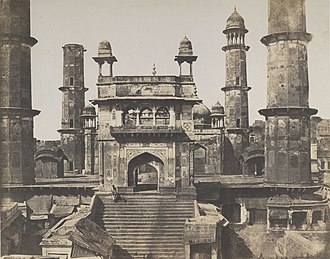
Juma Masjid of Mathura was completed by Abd-un-Nabi, governor of Aurangzeb in 1662. Abd-un-NabI khan, the founder of the masjid, was appointed as faujdar of Itawa by Aurungzeb; after some time, he was transferred to Mathura. Here he remained from 1660 to 1668 till he met his death at Sahora, a village in Mahaban Pargana on the opposite side of Yamuna, while engaged in quelling a popular uprising. The ground which Abd-un-Nabi Khan selected as the site of his mosque was, he purchased from some butchas, and the remainder, he obtained from a family of Kazis. Their descendants still occupy what is called Kusk Mahalla, one of the very few quarters of the city that are known by a Persian name. They continued to be regarded as zamindars of the township till the time of Jats. When Saijid Bakir, their head, quarreled with the local governor and made over all his rights to Chaubes, and others. The mosque has four minarets that are each 40 m (132 ft) high and a courtyard raised above the level of the street. The facade had the ninety-nine names of Allah with Persian inscriptions on either side.